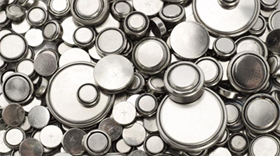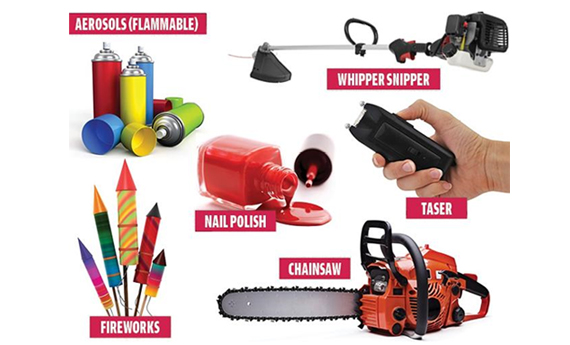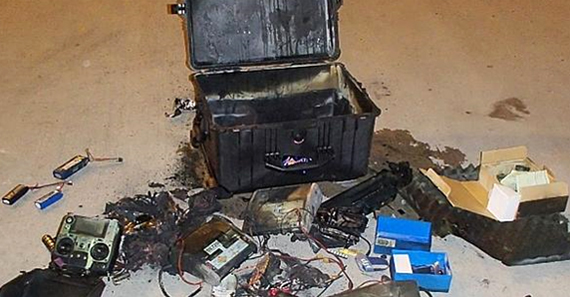Know the hazardous material rules and lithium content when carrying batteries.
Unresolved airplane crashes that were likely caused by batteries catching fire onboard during flight include the Asiana Airlines 747 near South Korea in July 2011, a UPS 747 in Dubai, UAE in September 2010 and a UPS DC-8 in Philadelphia, PA in February 2006. These events prompted changes to the UN Manual of Tests and Criteria in how batteries are certified for transport under UN 38.3.
Safety prompted authorities to tighten the rules when transporting batteries. Although lithium batteries get the most attention, the Federal Aviation Administration (FAA) says that based on records from 1991 to 2007 it was only a factor in 27 percent of all incidents. Lead acid, NiMH, NiCd and alkaline are also to blame. Reports say that short circuit, a preventable problem that can be solved with better packaging, is the largest problem. Figure 1 shows unprotected cells that can cause an electrical short by touching; propagation can create a chain reaction releasing a large amount of energy.
 |
|
Figure 1: Unprotected batteries. Much blame goes to faulty. Regulatory authorities recommend putting small batteries into clear plastic bags and placing them in a firm box with good padding. Limit the content per box. |
Lead Acid
| Spillable lead acid batteries are regulated as dangerous goods under Class 8, controlled by UN 2794. These batteries are considered dangerous goods because of the possibility of fire if shorted. Furthermore, an acid spill can cause personal injury and property damage. Figure 2 shows the HAZMAT Class 8 label that is commonly seen on trucks. The shipping rules are simple, well established and make common sense. When transporting Class 8 goods, note that a vehicle can only carry one type of hazardous material. Stack batteries upright on a wooden pallet, place honeycomb cardboard between layers and limit stacking to three layers per pallet. Wrap the pallet with shrink-wrap to improve stability. Add the “Corrosive” label, UN 2794 identification number and mark: “Wet, filled with acid.” Provide bill of lading with description of hazardous material, company and shipper’s name. Figure 3 shows do’s and don’ts. |

Figure 3: Do’s and Don’ts of shipping batteries by ground. Protect batteries from short circuit by placing cardboard insulator pads between layers and shrink-wrap. Failure to comply can lead to fines.
Some wet, non-spillable sealed lead-acid batteries grouped under UN 2800 are exempt from Class 8. The battery manufacturer must declare how a battery is regulated on its associated Material Safety Data Sheet (MSDS) and most AGM (absorbent glass mat) batteries can be shipped under the simpler UN 2800 directive. MSDS contains information on the potential health effects of exposure to chemicals or dangerous substances and on safe workplace procedures when handling chemical products.
Different rules apply when shipping damaged batteries. A lead acid battery is considered damaged if the possibility of leakage exists due to a crack or if one or more caps are missing. Transportation companies and air carriers may require draining the batteries of all acid prior to transport. Place damaged batteries in an acid-resistant container and add soda ash to neutralize any acid that might spill. Separate damaged and intact batteries.
Nickel-based Batteries
Nickel-based batteries have no transport limitations; however, some of the same precautions apply as for lead acid in terms of packaging to prevent electrical shorts and safeguard against fire. Regulations prohibit storing and transporting smaller battery packs in a metal box. If there is a danger of an electrical short, wrap each battery individually in a plastic bag. Do not mix batteries with coins and house keys in your pocket.
Lithium-based Batteries
The largest changes in shipping directive are with lithium batteries, and with good reasons. Li-ion is the fastest growing battery chemistry and already in 2009, 3.3 billion Li-ion were transported by air. Safety is an ongoing concern, and an airline-pilot union asked the FAA to ban lithium batteries on passenger aircraft. This came into effect in 2016 and lithium batteries are now shipped in cargo airplanes only.
Lithium batteries can only be transported after passing UN 38.3 testing requirements. In spite of these precautions, the U.S. Federal Aviation Administration (FAA) recorded 138 airport and air incidents between 1991 and 2016 involving lithium batteries. They involved smoke, heat and fire related to battery-operated devices such as e-cigarettes, laptops and mobile phones. Some incidents occurred before takeoff and the batteries were removed from the aircraft. Battery fires in flight were extinguished with halon type fire extinguishers and water, by placing the damaged device in a thermal battery containment bag that some airlines carry. Failing batteries in the cargo hold that were inadvertently checked into luggage required emergency landings.
Not all incidents are reported to the FAA, but the number of reported incidents is up from 2015. Recorded failures in 2016 alone involved 13 e-cigarettes, four laptops, seven mobile phones/tablets and seven spare batteries. E-cigarette incidents increased notably, while mobile phone and laptop events remain moderate considering the number of such devices in use.
Since 2008, lithium batteries can no longer be placed in checked baggage; they must be carried onboard. Air travelers are reminded of how many batteries they can carry with a portable device and as spares. Quick access to a fire extinguisher enables putting out a fire in the cabin should one take off. A coffee pot served as the fire extinguishing device for a flaming laptop battery in one reported incident. This is not possible with a burning battery in the cargo hold.
Transported lithium-based batteries are divided into two types: The rechargeable lithium-ion is primarily found in mobile phones and laptops; the non-rechargeable lithium-metal with added restrictions because of its high lithium content is used in sensing devices as well as in some consumer grade AA, AAA and 9V formats. Airlines allow both types as carry-on, either installed in devices or carried as spare packs as long as they don’t exceed the following limitation of lithium or equivalent content:
- 2 grams per battery for non-rechargeable lithium batteries, also known as lithium-metal.
- 8 grams per battery for a rechargeable lithium-ion. This amounts to a 100Wh battery.
- 25 grams total per passenger for all Li-ion combined, amounting to 300Wh.
The lithium content of a lithium-metal battery is printed on the label. Li-ion, on the other hand, uses equivalent lithium content (ELC) that is calculated by multiplying the rated capacity (Ah) times 0.3. For example, a 1Ah cell has 0.3 grams of lithium. A modern 18650 cell with a capacity of 3.3Ah contains about 1 gram. The 8-gram limit permits a 26Ah battery, or 95Wh (Ah multiplied by the Li-ion cell voltage of 3.6V equals Wh). The 18650 is a standardized Li-ion cell of 18mm in diameter and 65mm in length, and is used in laptops, power tools and other devices. Most laptop batteries are in the 60Wh range.
While regulations limit the Li-ion battery to no larger than 100Wh, each passenger is allowed to carry two spare packs of 160Wh each, not exceeding 320Wh in total. The airlines recommend placing each battery in a clear plastic bag to prevent electric short. Batteries that are contained (non-removable) within a device and are not easily removable are exempt from the rules. These include electric watches, smartphones and laptops but not power tools with interchangeable battery packs. (See BU-704a: Shipping Lithium-based Batteries by Air.)
All lithium batteries are considered to be dangerous goods and transporting them requires compliance with Class 9 directives. However, exemptions are made when shipping these batteries in small quantities. Personnel transporting lithium batteries commercially must be trained. Organizations such as iHazmat or the International Compliance Center (ICC) educates shippers and packers in the handling of dangerous goods consistent with to International Air Transport Association (IATA) requirements and issues a certificate of compliance to those participants who pass a written examination. Those not familiar with these restrictions often ask some of the following questions:
| Q: | Must consumer-type lithium-ion batteries always be shipped under Class 9? |
| A: | No. Most Li-ion in consumer products are less than 100Wh and an exemption is made here but CAUTION labeling is required. |
| Q: | What quantities can I ship outside of Class 9? |
| A: | Cells with a maximum rating of 20Wh and not exceeding 8 in quantity, or 2 batteries with a maximum rating of 100Wh each as part of Section II. (See BU-704a: Shipping Lithium-based Batteries by Air.) |
| Q: | When does Class 9 apply? |
| A: | Lithium-based batteries classified under Section IA and IB. |
| Q: | Must lithium-ion batteries be tested for shipment? |
| A: | Yes, all Li-ion must be tested according to UN 38.3. Exceptions are made for prototypes and testing purposes. Refer to CFR 49 173.185 (e) for requirements regarding the shipment of cells or batteries that have not been tested to the requirements to UN 38.3. |
Since 2016, lithium batteries can no longer be carried in passenger aircraft as cargo. Transporting them are organized by Packaging Instructions (PI) numbers. The most common designations include:
| PI 965 | Loose Li-ion cells and packs (UN 3480) |
| PI 966 & 967 | Li-ion with/in equipment (UN 3481) |
| PI 968 | Lithium-metal cells and battery packs (UN 3090) |
| PI 969 & 970 | Lithium-metal with/in equipment (UN 3091) |
Each PI is further divided into Sections representing IA, IB and II (Roman numerals). IA is most stringent, and for simplicity this article lists the less restricted packaging first:
| Carry-on | Maximum 100Wh, passenger can take 2 spares up to 160Wh each, not exceeding 320Wh. No check-in allowed. |
| Section II | Shipment of small Li-ion in low numbers. These can include up to 8 cells not exceeding 20Wh each and up to 2 packs not exceeding 100Wh each at a total weight of 2.5kg. Batteries must be at 30 percent state-of-charge (SoC) for shipment. Persons preparing such shipment is exempt from dangerous goods training, but must be provided with “adequate instruction.” |
| Section IB | Shipment of small Li-ion products in larger numbers under Class 9 dangerous goods. Similar to Section II with a 10kg cargo limit per package. Batteries must be at 30 percent SoC. Training and certification is mandatory. |
| Section IA | Larger Li-ion products under Class 9 dangerous goods. Cells can be larger than 20Wh and battery packs can exceed 100Wh, but the package limit is 35kg. Batteries must at 30 percent SoC. Training and certification is mandatory. (See BU-704a: Shipping Lithium-based Batteries by Air.) |
See also http://www.iata.org/whatwedo/cargo/dgr/Documents/lithium-battery-guidance-document-2017-en.pdf, entitled “2017 Lithium Battery Guidance Document.”
Be mindful when traveling by air
Shippers and passengers must be aware that batteries are not the only dangerous good banned on an aircraft as cargo or in checked luggage. Travelers often put the safety of other passengers in danger by checking in or bringing on board banned items. Figure 4 illustrates some of these forbidden goods. The Australian Civil Aviation and Safety Authority (CASA) remind travelers to declare potentially dangerous goods. Check dangerous goods under CASA if uncertain what is allowed.

Figure 4: Banned consumer goods on an aircraft. If uncertain what items are banned, check “dangerous goods” under CASA or other websites.
Source: Daily Telegraph
Mishaps remind travelers of the importance to observe safety bylaws. In 2014, the captain of a Boeing 737 aircraft declared “Mayday” after observing heavy white smoke billowing from the cargo hold of the plane during an external pre-flight inspection. Emergency crew uncovered 28 batteries in a checked transit case, 6–8 of which had been destroyed by fire. The report said that an electrical short in a battery started the fire after the passenger declared that no batteries were in the transit case. Under civil aviation laws, passengers failing to declare dangerous goods face penalties of up to 7 years in prison. Figure 5 illustrates the remains of the charred content.

Figure 5: Exploded transit case. CASA examines the remains of checked luggage after a battery caught fire before take-off. The dangerous goods were not declared. Shipping of lithium-based batteries is regulated under UN 38.3.
Source: Daily Telegraph
Regulations are only as good as actual adherence to the rules. Shipment of dangerous goods can be circumvented by deliberately mislabeling batteries. There are reported cases where Li-ion was marked with NiCd, a chemistry that is not classified as dangerous goods. In other cases, lithium-metal with strictest requirements was listed as more benign Li-ion. Battery chemistries are difficult to identify and the offense may go undetected. Tightening rules only makes sense if they can be administered policed with reasonable ease; imposing rules that are too stringent will invite lawbreakers. Only purchase lithium batteries that come from a reputable company. Check that the batteries meet the UN Manual of Test and Criteria requirements.
Use Common sense when carrying Batteries
Avoid storing and transporting small batteries in a metal box. Do not carry batteries with coins and house keys in your jeans. Batteries can short circuit and release high amounts of energy, especially lithium systems. While a household alkaline may get hot when shorted, lead acid will draw high current for a few seconds, heat up and possibly spill. Lithium-ion is most treacherous especially when fully charged. An unprotected Li-ion cell or battery pack continues to draw high current that can lead to a violent self-destruction and injury through heat exposure and venting with flame.

